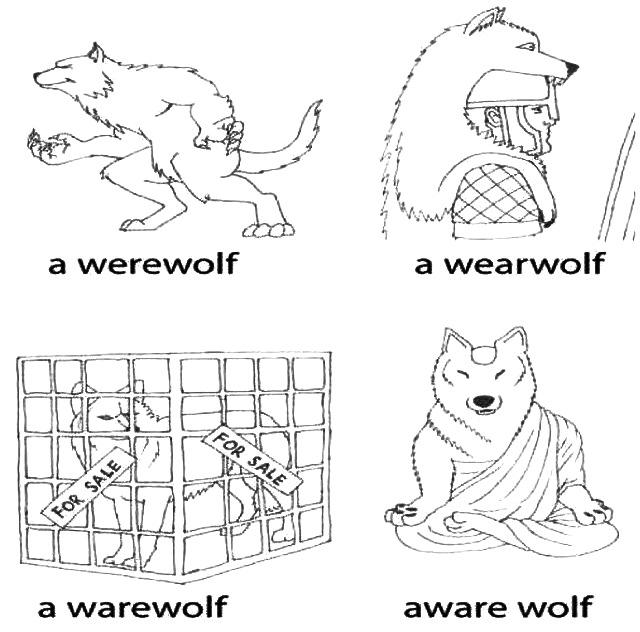Having fun with homonyms in English Posted by Gabriele on Feb 2, 2016 in English Language, English Vocabulary
Homonyms are words that sound the same, but are spelled differently, and have different meanings. The picture above shows how a person can play with homonyms in a humorous way. The first words in this graphic “a werewolf,” is a word that describes a mythical creature that is part wolf, part man. By using the homonym ‘wear,’ in place of ‘were,’ the homonym a “wearwolf” is made. This isn’t technically a word in English, but it certainly describes the picture of a man wearing a wolf very well. Next, we have the homonym ‘ware’ and ‘wolf’ making “warewolf.” Ware is an English word used to indicate that something is for sale. Lastly, my favorite, is an “aware wolf.” This homonym phrase is made by using the word ‘aware,’ which means knowledgeable, and ‘wolf’. This is just one example of a group of English homonyms, some of which are made-up words, which are used as wordplay. There are a lot more homonyms in English and today we are going to exploring some of them.
Take a look at this sentence, which has an example of a well-known and commonly used set homonyms.
“The two women wanted to go shopping and out to lunch too.”
To, too, and two are homonyms.
One of the key features of homonyms to keep in mind is that they are words that sound alike, so when a person is speaking, the only way to know which homonym is being used is to listen to the context. When homonyms are written it is easy to see which word is being used as the spelling is different, but in spoken English knowing this can be a little tricky, especially for ESL learners.
Let’s take a look at some common English homonyms so you can familiarize yourself with these for when you hear them in the future. Remember these words SOUND alike when spoken, even though some LOOK very different when written.
ate – eight
aisle – I’ll
be – bee
bight – bite – byte
buy – by – bye
cent – scent – sent
cite – sight – site
dew – do – due
ewe – you
eye – I
fir – fur
for – fore – four
hi– high
idle – idol
knot – not
knows – nose
knew – new
maid – made
meet – meat
or – oar
poor – pour
praise – prays
rain – reign – rein
read – red
road – rode
seas – sees – seize
sew – so – sow
tea – tee
their – they’re – there
ware – wear – where
way – weigh – whey
weather – whether
won – one
you’re – your – yore
Here are some fill in the blank sentences in which you have to try and figure which homonym goes where. These shouldn’t be too hard to figure out if you pay attention to the context.
1. Did you __________ that _________dogs are allowed in the park? It’s not a dog park.
no – know
2. We didn’t ________ any whales in the __________.
see – sea
3. There is no need to ______ scared of a little bumble __________.
be – bee
4. I can’t wait to _________ Beyoncé when she is ________ in concert.
here – hear
5. ___________ are you ever going to _________ that ridiculous shirt?
wear – where
6. James _________ that book with the _______ cover for class.
red – read
7. My mother __________ the horse down the ___________ to the neighbors for help.
rode – road
8. We ________ dinner at _________ o’clock.
eight – ate
9. You can call this a paddle ________ an __________; they are the same thing.
oar – or
10. I’m sorry my _________ isn’t very good, can you read what source they _______ on this web_________.
site – sight – cite
Scroll down for the answers.
Answers:
1. know, no
2. see, sea
3. be, bee
4. hear, here
5. Where, wear
6. read, red
7. rode, road
8. eight, ate
9. or, oar
10. sight, cite, site

Build vocabulary, practice pronunciation, and more with Transparent Language Online. Available anytime, anywhere, on any device.
About the Author: Gabriele
Hi there! I am one of Transparent Language's ESL bloggers. I am a 32-year-old native English speaker who was born and raised in the United States. I am living in Washington, DC now, but I have lived all over the US and also spent many years living and working abroad. I started teaching English as a second language in 2005 after completing a Master's in Applied Linguists and a Certificate in English Language Teaching to Adults' (CELTA). Since that time I have taught ESL in the United States at the community college and university level. I have also gone on to pursue my doctorate in psychology and now I also teach courses in psychology. I like to stay connected to ESL learners around the world through Transparent Languages ESL Blog. Please ask questions and leave comments on the blog and I will be sure to answer them.




